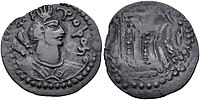Uzbeks
The Uzbeks (Uzbek: Oʻzbek, Ўзбек, اۉزبېک, plural: Oʻzbeklar, Ўзбеклар, اۉزبېکلر) are a Turkic ethnic group native to the wider Central Asian region, being among the largest Turkic ethnic group in the area. They comprise the majority population of Uzbekistan, next to Kazakh and Karakalpak minorities, and are also minority groups in Afghanistan, Tajikistan, Kyrgyzstan, Kazakhstan, Turkmenistan, Russia, and China.[15] Uzbek diaspora communities also exist in Turkey, Saudi Arabia, United States, Ukraine, and other countries.
This article is about Uzbeks as an ethnic group. For information about citizens of Uzbekistan, see Demographics of Uzbekistan. For a list of notable people from Uzbekistan, see List of Uzbeks.Culture and society
Uzbek tribes
Uzbeks are said to have included 92 tribes in their orbit: Manghut, Qiyat, Qipchaq, Khitai, Qanghli, Kenigas, Durman, Darghut, Shoran, Shurin, Toma, Bahrin, Giray, Aghrikur, Anghit, Barkut, Tubin, Sart, Romdan, Matin, Busa, Yojqar, Qilwa, Dojar, Jurat, Qurlat, Mehdi, Kilaj, Sakhtiyon, Qirgh, Ming, Yuz, Salor, Loqai, Qushchi, Kerait, Chaqmok, Utarchi, Turcoman, Arlot, Kait, Qirghuz, Qalon, Ushin, Ormaq, Chubi, Lechi, Qari, Moghul, Hafiz dad Kaln, Belad Bustan, Quchi Qetaghon, Barlos, Yabu, Jaloir, Musit, Naiman, Semarjiq, Qarluq, Arghun, Oklan, Qalmaq, Fuladchi, Jalot Uljin or Olchin, Chimbay, Tilab, Mochar or Majar, Ojinbay, Badoy, Kelchi, Ilaj, Jebirgan, Botiya, Timan, Yankuz, Tatar, Uighur, Baghlan or Baghan, Danghut, Shagird, Pesha, Tushlub, Onli, Biyat, Ozlaji, Joslayi, Tuwadiq, Ghariband Jit.[119][120][121] For the semi-nomadic tribes of these khanates, belonging to the "92 tribes" meant in certain cases a privileged position and a higher socio-economic status. In certain cases, the term "92 Uzbek tribes" was used with a political meaning to legitimize the ruling Uzbek dynasties of the Manghyts and Mings.[122]

